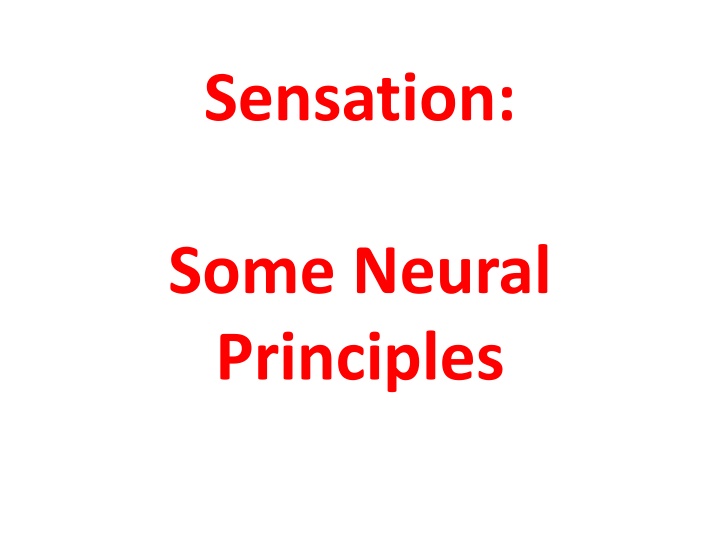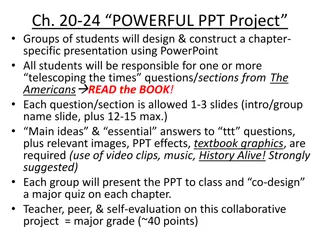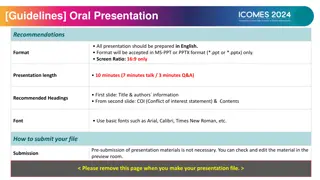
Understanding Sensory Coding and Neural Principles
Explore the world of sensation and neural principles through topics like sensory coding, neural adaptation, receptive fields, lateral inhibition, and more. Gain insights into how information is processed and uncertainties reduced in the sensory system. Dive deep into the mechanisms that govern sensory responses and learn about the fascinating neural underpinnings of perception.
Download Presentation

Please find below an Image/Link to download the presentation.
The content on the website is provided AS IS for your information and personal use only. It may not be sold, licensed, or shared on other websites without obtaining consent from the author. If you encounter any issues during the download, it is possible that the publisher has removed the file from their server.
You are allowed to download the files provided on this website for personal or commercial use, subject to the condition that they are used lawfully. All files are the property of their respective owners.
The content on the website is provided AS IS for your information and personal use only. It may not be sold, licensed, or shared on other websites without obtaining consent from the author.
E N D
Presentation Transcript
Sensation: Some Neural Principles
Sensory Codes Code A set of rules that provide information. Information - The reduction of uncertainty. Sensory Code A set of rules that provide information (reduce uncertainty) about the environment via detectors (sensors).
Sensory Codes Rate Code A sensory rule by which stronger stimuli generate more action potentials per unit time. strong stimuli -> hire firing rate Time Code A sensory rule by which stimuli generate unique patterns or rhythms of action potentials.
https://en.wikipedia.org/wiki/Neural_oscillation Sensory Codes
http://en.wikipedia.org/wiki/Neural_adaptation Sensory Adaptation Sensory (Neural) adaptation the reduction in the nervous system s response to a repeated stimulus. Sensory adaptation experiments often generate psychological aftereffects. Example: Time 1: Place hand in room temperature water. Time 2: Adapt to (place hand in) hot water. Time 3: Place hand in room temperature water, which now feels cold.
Neural Receptive Fields Sensory neurons have Receptive Fields the range of stimuli to which the neuron responds. Example: Some neurons in your occipital lobe respond to the center of your retina (the proximal stimulus), others respond to only to either the nasal-retina or temporal-retina.
http://en.wikipedia.org/wiki/Lateral_inhibition Lateral Inhibition Lateral Inhibition The ability of an active neuron to reduce the firing rates of neighboring neurons. Center Surround Antagonism a form of lateral inhibition in which concentric regions of a receptive field have competitive interactions. Example: Some neural receptive fields have on centers and off surrounds
On-Center Ganglion Cell Neuron Receptive Field - - - - - ++ ++ + + - - + + + + -- - - - - - Responds maximally to light increments in the center, and light decrements in the surround.
Receptive Field On-Center Cells Love Stimuli like this. - - - - - ++ ++ + + - - + + + + -- - - - - -
Receptive Field On-Center Cells Hate Stimuli like this. - - - - - ++ ++ + + - - + + + + -- - - - - -
Receptive Field Off-Center Ganglion Cell + + + + - - + - - - - - - - - + + + Responds maximally to light decrements in the center, and light increments in the surround.
Receptive Field Off-Center Cells Love Stimuli like this. + + + + - - - + - -- -- - - - + - - + - + + +
Receptive Field Off-Center Cells Hate Stimuli like this. + + + + - - - + - -- -- - - - + - - + - + + +
http://en.wikipedia.org/wiki/File:HermannGrid.gif Center Surround Antagonism The Hermann grid illusion






















